$DB Token Utilities
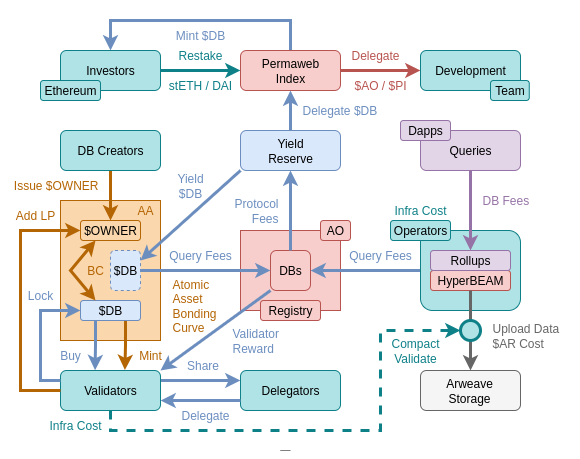
$DB is the operating currency of the Verifiable Data Economy. Every query, every database, and every liquidity pool ties back to $DB. Unlike Web2 cloud infrastructure, where value stops at corporations, every action flows back into a decentralized economy secured by $DB.
1. Core System Architecture
1.1 Fair Launch Pool Distribution
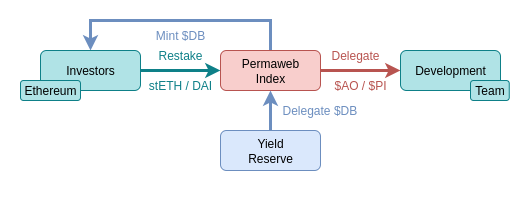
The FLP distributes 30% of supply (300M $DB) over 30-40 years through the Permaweb Index with 0.9997 daily decay rate. Tokens become transferable one year after FLP start.
→ Fair Launch Details - Complete emission mechanics and distribution schedule
1.2 Database Token Generation Events (DBTGE)
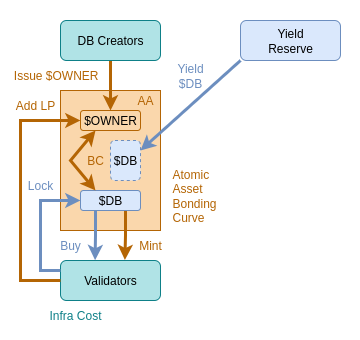
Starting month 9, users lock $DB for 3 months to 4 years, receiving veDB points that determine their share of database-specific token emissions. The Yield Reserve allocates $DB yield to databases based on total veDB, then mints dbX tokens 1:1 against that yield.
→ Database Launch Architecture - Technical implementation details and veDB mechanics
1.3 Validator Network Operations
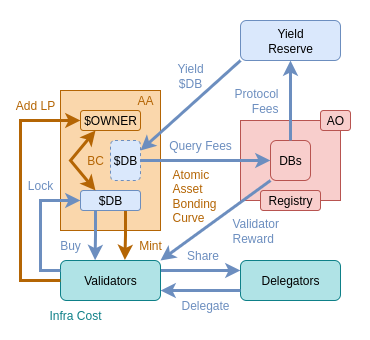
Validators provide essential network security and query processing services through a delegated staking model.
Validator Functions:- Compact and Validate queries from applications
- Maintain Registry of database states and cross-database routing
- Process queries and generate cryptographic proofs
- Coordinate with Operators for final data settlement
- Validators stake $DB as security deposit
- Delegators can delegate $DB to validators, sharing rewards
- Query Fees split between protocol, validators, and delegators
- Infra Cost subsidies provided during network growth phase
- DB Fees from applications flow to validator network
- Validator Rewards distributed based on stake and performance
- Protocol Fees support Yield Reserve for ecosystem development
1.4 Application Revenue Model
Applications operate through a token-based economy where users pay database-specific tokens for operations:
Usage Economics:- Write Operations: Posts, comments, follows, updates
- Read Operations: Feeds, searches, queries, analytics
- Premium Features: Enhanced functionality, priority processing
- Governance Participation: Voting rights, proposal submission
Users acquire dbX tokens → Pay for app features → App collects revenue →
App pays operators in $DB → Query processing and storageThis creates sustainable demand for both database-specific tokens and underlying $DB through operational requirements.
1.5 Operator Infrastructure Settlement
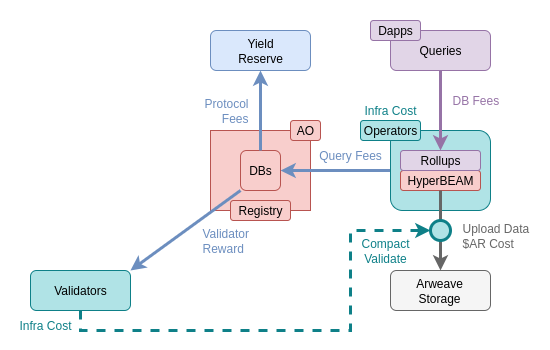
Operators provide the critical infrastructure for data persistence and query execution.
Operator Responsibilities:- Run HyperBEAM nodes with rollup servers
- Handle final Upload Data to Arweave Storage with $AR Cost
- Process queries from DBs through AO Registry
- Maintain Rollups/HyperBEAM infrastructure for data compaction
- All queries settled in $DB regardless of database token used
- DB Fees flow from applications to operators via registry
- Infra Cost subsidies provided through Yield Reserve during growth
- Creates structural $DB demand scaling with network usage
- Dapps submit Queries to database layer
- DBs process queries and route through AO Registry
- Operators handle Query Fees and execute Rollups/HyperBEAM
- Final data Compacted and Validated before Arweave Storage
2. Structural Demand Generation
Every database operation creates multiple layers of $DB demand:
Direct Demand:- Query settlement requires $DB regardless of database token used
- Validator staking removes $DB from circulation
- Cross-database routing uses $DB as universal liquidity medium
- Operator payments create consistent demand floor
- Database token acquisition drives $DB demand through veDB locking
- Application revenue conversion requires $DB for infrastructure payments
- Yield farming and LP participation lock $DB in productive activities
- Governance participation incentivizes long-term $DB holding
3. Revenue Transition Timeline
Phase 1: Infrastructure Support (Months 1-12)- High veDB boosts provide maximum protocol funding to databases
- Yield Reserve subsidizes operator costs and validator rewards
- Focus on database development and user acquisition
- Declining veDB boosts reduce protocol dependency
- Increasing Query Fees and trading activity
- Balance between emissions and market-driven revenue
- Minimal protocol emissions, primarily market-driven economics
- Revenue from Trading Fees, Query Fees, and token appreciation
- Mature database ecosystems with independent value creation
4. Participant Value Alignment
Users:- Free, frictionless access to applications with Web2-like experience
- dbX tokens provide governance rights and premium features
- No direct $DB interaction required for basic usage
- Yield Reserve covers infrastructure costs during development
- DBTGE provides initial funding without upfront capital requirements
- Flexible monetization through subscriptions or autonomous funding
- Query Fees and Yield Reserve subsidies ensure profitability
- Scale earnings with network growth and transaction volumes
- Validator staking provides consistent reward streams
5. Realistic Economic Model
5.1 Development Expectations
Infrastructure Timeline:- 18-24 months for operators to achieve modest profitability (15-35% ROI)
- Professional infrastructure requires patient capital and gradual scaling
- Yield Reserve provides bridge funding during user acquisition
- Successful databases generate $8,000-50,000 monthly revenue
- 2-3 years typical development time for sustainable user bases
- Focus on utility development over speculative trading
5.2 Why This Model Works
Real Utility Creation:- Every query creates $DB demand through operator settlement requirements
- Database tokens have genuine utility for application features
- Cross-database routing creates network effects and additional demand
- Infrastructure necessity ensures sustainable compensation models
- User success drives query volume and $DB demand
- Developer success creates more valuable database economies
- Infrastructure provider success ensures network reliability and growth
- Long-term thinking encouraged through lock mechanisms and veDB boosts
- Yield Reserve provides patient capital for development phase
- Multiple revenue streams reduce single points of failure
- Gradual transition from subsidized to market-driven economics
The $DB utility model creates a foundation where providing valuable database services generates reasonable returns for participants patient during the development cycle, with protocol mechanisms that enable sustainable business planning and user confidence in the token ecosystem.
